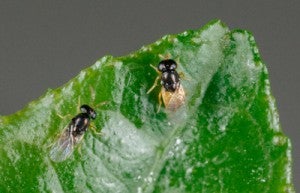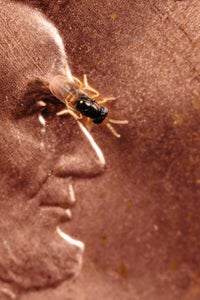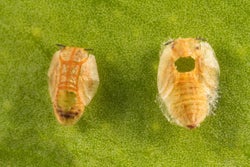
The Problem

Asian citrus psyllid (ACP) is a serious threat to California’s citrus because it spreads a bacterium that causes a lethal disease of citrus, huanglongbing, which was first detected in Hacienda Heights, Los Angeles County in March 2012. One way to reduce the rate of spread of HLB is to reduce the populations of ACP living on citrus in urban areas. This will have two important impacts: (1) it will reduce the rate of spread of HLB by ACP, and (2) fewer ACP will migrate from urban areas into commercial citrus production areas threatening organic and conventionally-grown citrus. One way to suppress ACP populations in urban areas without the use of pesticides is through biological control, the use of natural enemies to reduce pest population densities.
On 16 December 2014, the biological control project targeting ACP took a significant step forward when 556 Diaphorencyrtus aligarhensis (Hymenoptera: Encyrtidae) (Fig. 1) were released at the University of California Riverside (UCR) Biological Control Grove. The release occurred at 9:00am and was attended by approximately 40 people representing UCR, the Citrus Research Board (CRB), the California Department of Food and Agriculture (CDFA), local pest control advisors, and media representatives.

The first of 15 vials that contained parasitoids was opened by Chancellor Kim Wilcox (Fig. 2), the remaining vials were distributed amongst attendees, who opened and tied them to branches of lemon trees in the Biocontrol Grove. The sex ratio of this Pakistani parasitoid is ~50% female and ~50% male. The road to releasing Diaphorencyrtus in California was long. The parasitoid was first collected from Punjab Pakistan in March 2011 and recovered from ACP nymphs until a sixth and final collecting trip was completed in April 2013. A total of 1,023 Diaphorencyrtus were collected in Pakistan and returned to the quarantine facility at UCR.
How Safe is Diaphorencyrtus for California?

Diaphorencyrtus is a tiny parasitic wasp (Fig. 3), it can’t sting people or animals, it doesn’t eat plants, and unlike ACP it can’t spread the bacterium that causes huanglongbing, the disease that kills citrus. Safety testing to determine the host specificity of Diaphorencyrtus took almost 18 months to complete in quarantine at UCR. This process involved exposing this parasitoid to non-target psyllid species that included native psyllid species and psyllids used as weed biocontrol agents to determine its host range (i.e., the number of psyllid species it can attack) and host specificity (i.e., which psyllid species are most preferred for parasitism). Results from no-choice and choice tests were used to prepare an 84 page Environment Assessment Report that was submitted to USDA-APHIS for review on 1 November 2013. The results of experiments demonstrated that Diaphorencyrtus has a very strong preference for ACP nymphs and likely poses little environmental risk. On 24 November 2014, USDA-APHIS issued the official release permit, P526P-14-04034, to move Diaphorencyrtus out of quarantine for release and use in California as a biocontrol agent of ACP.
Overview of Diaphorencyrtus Biology

Diaphorencyrtus is an endoparasitoid that can parasitize second through fourth instar ACP nymphs, but second and third instars seem to be preferred (Fig. 4). All parasitized ACP nymphs, regardless of stage that is parasitized, continue to feed, develop, and molt to the fifth and final instar before they turn into mummies. Curiously, Diaphorenyrtus is unable to develop in late stage fourth instar (i.e., nymphs that are older than 7.5 days of age) as for some unknown reason parasitoid eggs don’t hatch (. Fifth instar ACP nymphs are also unsuitable for oviposition because the cuticle maybe too thick to pierce with the ovipositor and defensive twitching by these large nymphs may deter ovipositing females.

Development from egg to adult parasitoid emergence takes about 16 days at 77oF (25oC). During this developmental period parasitoid larvae passes through four larval instars, or developmental stages, before reaching a pre-pupal stage that transitions into the pupa. Developmental times for Diaphorencyrtus eggs, first and second instar larvae are about 2 days; the third, fourth, and pre-pupal stages last around 1 day, while the pupal stage takes seven days to complete. During the third instar, Diaphorencyrtus larvae use secretions from the tip of the abdomen to anchor themselves within the thoracic region of body cavity of the ACP nymph. Once secured, parasitoid larvae then position themselves with the posterior of their bodies aligned with the head of the ACP nymph and the larval head or anterior region facing the posterior of the host.

Therefore, when adult Diaphorencyrtus emerge, they chew an exit hole at the posterior end of the ACP mummy through which they escape. In contrast, Tamarixia chews an exit hole in the anterior or head region of the ACP nymph to emerge (Fig. 5). Diaphorencyrtus females obtain protein for maturing eggs by host feeding on ACP nymphs. To host feed, females use their ovipositor to pierce the body of the ACP nymph, hemolymph or insect blood, leaks from these wounds and is eaten by females. The trauma of being stabbed and then fed upon is often sufficient to kill ACP nymphs. Additionally, adult Diaphorencyrtus may gain nutrition from eating ACP honeydew, the dried white material that is exuded by feeding nymphs (Fig. 6).
The Diaphorencyrtus Release Plan for California
Releases of Diaphorencyrtus are planned for areas where Tamarixia has either not been released or surveys indicate that selected areas near Tamarixia release sites have little or no activity associated with this parasitoid. The reason for this strategy is to minimize competition between Diaphorencyrtus and Tamarixia so as to give Diaphorencyrtus the best possible chance to establish. To select sites for Diaphorencyrtus releases we are working closely with the CDFA to identify suitable sites that encompass a variety of different climatic conditions. For example, Tamarixia-free sites in the Coachella Valley have been identified and scouting is underway to look for suitable release areas in Riverside and Los Angeles Counties. Past experience suggests that establishing more than one natural enemy of a citrus pest in California can increase the chances of successful biological control. Perhaps one of the best recognized cases is that concerning the cottony cushion scale, Icerya purchasi, with the predatory beetle, Rodolia cardinalis, and the parasitic fly, Cryptochaetum iceryae. Surveys indicate that the beetle provides control in arid desert interior regions, while the fly dominates in cooler coastal areas where citrus is grown. Parasitoid releases will be made when ACP stages are abundant for parasitism and host feeding. Site security needs to be ensured to minimize preventable accidents such as pesticide sprays or pruning of trees which could accidentally eradicate incipient Diaphorencyrtus populations.
How Well Will Diaphorencyrtus Control ACP in California?
Diaphorencyrtus populations sourced from Taiwan, Vietnam, and China (these are all female colonies) have failed to establish in Florida despite multiple release efforts involving more than 11,000 parasitoids. Reasons for this are unknown, but could be due to heavy pesticide use to control ACP, lack of synchrony between releases and ACP life stages suitable for parasitism, competition from Tamarixia, and possible predation of parasitized nymphs. Other factors may include low genetic diversity (because these parasitoids in Florida are all female they don’t reproduce sexually) and too little investment put into release and establishment efforts.
In many countries Tamarixia and Diaphorencyrtus coexist (e.g., Vietnam, China, and Taiwan) and in Pakistan the results of ~ 2.5 year long surveys in kinnow mandarin and sweet orange suggest that average year round parasitism of ACP nymphs by Diaphorencyrtus is ~ 20% while Tamarixia accounts for ~30% parasitism each year (Khan et al., 2014). In Saudi Arabia, Diaphorencyrtus may be the only parasitoid species attacking ACP nymphs infesting Mexican limes with maximum parasitism rates of 64-71% being recorded.
It is impossible to predict what level of ACP suppression Diaphorencyrtus is likely to provide in California. It is anticipated that if Diaphorencyrtus establishes it will complement the activity of Tamarixia thereby increasing overall ACP mortality. It is possible that if Diaphorencyrtus does establish in may have ecoclimatic preferences different to that of Tamarixia which may allow it to provide control in areas where Tamarixia is not effective. The only way to determine these potential outcomes is through a multi-year research program that tracks the establishment, spread, and impact of Diaphorencyrtus on ACP in urban and commercial citrus production areas in California.